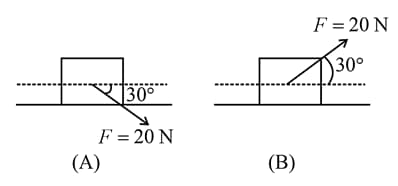EASY
Earn 100
A block is attached to a horizontal spring of stiffness . The other end of the spring is attached to a fixed wall. The entire system lie on a horizontal surface and the spring is in natural state. The natural length of the spring is . If the block is slowly lifted up vertically to a height from its initial position. which of the following is not correct:
(a)The work done by the gravity
(b)The work done by the spring force
(c)The work done by the lifting force
(d)The sum of works done by all the forces on the block is zero
50% studentsanswered this correctly
Important Questions on Laws of Motion
EASY
EASY

Given in the figure are two blocks and of weight and , respectively. These are being pressed against a wall by a force and kept in equilibrium as shown. If the coefficient of friction between the blocks is and between block and the wall is , the frictional force applied by the wall on block is:
EASY
EASY
EASY
EASY
MEDIUM
Consider the system shown below.

A horizontal force is applied to a block of mass such that the block of mass adjacent to it does not slip downwards under gravity. There is no friction between the horizontal plane and the base of the block . The coefficient of friction between the surfaces of the blocks and is . Take acceleration due to gravity to be . The minimum value of is
EASY
EASY
HARD
EASY
MEDIUM
HARD
HARD
A block of mass is (i) pushed in case and (ii) pulled in case by a force making an angle of with the horizontal, as shown in the figures. The coefficient of friction between the block and floor is The difference between the accelerations of the block, in case and case will be:

MEDIUM
EASY
EASY
EASY

